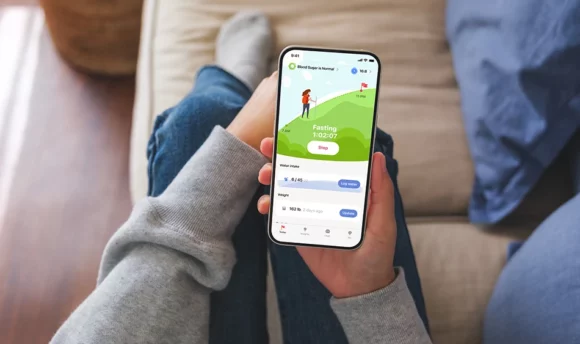How to Fast for a Day: A Step-by-Step Guide
A 24-hour fast can be beneficial for your health, but only if you do it the right way. In this article, we’ll discuss a detailed step-by-step process to fast for a day effectively.

Fasting for a day is the practice of refraining from eating for 24 hours. It gives your body a break and can offer many health benefits.
It might not be the simplest intermittent fasting protocol, but you can follow it successfully if you use the right steps.
In this article, we’ll discuss a step-by-step guide that will help you adhere to this fasting technique. Read on to discover how to fast for a day and unlock the potential benefits it can bring to your health.
How to Fast for a Day Safely
Different people can have different intentions for fasting. Some people do it to reap the benefits it offers, like weight loss and reduced blood pressure. At the same time, others use fasting for spiritual and religious purposes.
To ensure a safe experience, you should choose the fasting method that suits your needs. It’ll help you maximize the benefits of fasting and achieve your goals faster.
With that said, it’s important to note that fasting for a day is not the best option for everyone. It’s especially true if your goal is to reduce body weight.
Research suggests that if you fast for 10–16 hours, your body starts using its fat stores to produce energy. It increases the level of ketones in your bloodstream and encourages fat loss.
However, a 24-hour (or longer) fast can be counterproductive in terms of burning fat. That’s because it makes your body go into starvation mode. As a result, your body can start storing more fat rather than burning it.
It means that you shouldn’t opt for the 24-hour fasting protocol if your main goal is to lose weight. But if you want to improve your overall health, a full-day fast can be a great option.
Here’s how you can do it the right way.
Prepare for the Fast
It’s not advisable to start a 24-day fast without any preparation, as it can lead to several health issues. So, consider preparing properly using the following steps.
#1 Define your fasting window
The first step in preparing for the fast is to define your fasting window. You need to determine the specific 24-hour timeframe during which you won’t consume any food.
It’s also important to reflect on the purpose of your fast and set an intention for the day.
So, consider what you hope to gain from the experience. It can be spiritual development, physical benefits, or improvement in mental health. Doing so will help you approach the fast with clarity and purpose.
#2 Make sure you’re hydrated
While it’s important to stay hydrated during the fasting periods, you should also practice the same in the days leading to your fast day.
Water plays a vital role in maintaining proper bodily functions and preventing dehydration. Aim to drink the recommended amount of fluid each day, which is around 3.7 liters for men and 2.7 liters for women.
Also, avoid excessive intake of dehydrating beverages like alcohol and caffeinated drinks. It’ll minimize discomfort and support your overall well-being during the fast.
#3 Eat nutritious foods the day before
To prepare for a day of fasting, it’s important to consume nutritious foods the day before. Follow a balanced diet that includes a variety of fruits, vegetables, lean proteins, whole grains, and healthy fats.
These foods will provide your body with the energy it needs to go through the fast easily.
Avoid sugary and processed foods as they can cause energy crashes and hunger pangs. Additionally, they can also make you feel even hungrier. So, focus on nourishing your body with wholesome and nutrient-dense meals.
You should also add high-fiber food options to your diet. That’s because they promote feelings of fullness and aid in digestion.
Tips for Getting Through the Fast
Once you’ve started the fast, you’ll need to ensure you stay on track to complete it successfully. Here are some important tips that will help you with that.
#1 Drink enough water
It’s critical to drink a lot of water and other fluids to stay hydrated during the fast. Otherwise, you can fall victim to fasting headaches, which is a frustrating experience.
Make sure you listen to your body’s thirst signals and drink water whenever you feel the need. You can also drink other calorie-free drinks like non-sweetened drinks and black coffee.
Additionally, keep your electrolytes in check and consume them whenever needed. They can prevent muscle cramps and help you stay energized.
#2 Avoid strenuous exercise
Keep in mind that your calorie intake will reduce dramatically during the fast. And calories are what your body uses to generate energy.
If you start performing strenuous exercise while fasting, your body will burn calories faster, and it can backfire. Not only will it cause your metabolism to drop, but it will also increase the risk of fainting, nausea, dizziness, and headache.
It can be extremely dangerous for people with diabetes as it can lead to dangerously low blood sugar levels. Research suggests that it can cause or even worsen hypoglycemia.
#3 Stay busy
Keeping yourself busy is one of the best ways to get through the fast. It prevents you from thinking about food and resisting the temptation to break the fast.
Spend time with your loved ones or engage in activities you enjoy, like reading, working, or walking.
Don’t forget to listen to your body’s signals and rest when needed, but stay active and engaged whenever possible to navigate the fast easily.
#4 Keep your goal in mind
Keeping your goal in mind is essential during different stages of fasting. Whether it’s for health benefits or spiritual reasons, reminding yourself about it will help you stay motivated.
Visualize the outcome and use it as a source of inspiration during moments of temptation. This way, you’ll be able to maintain a positive mindset and reach the end of your fast successfully.
Break the Fast
Once it’s time to break the fast, you’ll be feeling hungry and tempted to eat everything in sight. You should avoid doing so, as it can lead to discomfort and potential digestion issues.
Use the following tips to break the fast the right way.
#1 Choose nourishing food
It’s essential to choose nourishing foods that are rich in nutrients while breaking the fast. Consume whole, unprocessed options such as fruits, vegetables, lean proteins, and whole grains.
These foods contain vitamins, minerals, and fiber, which means they can replenish your energy levels. Avoid opting for processed food that can cause digestive discomfort or disrupt your body’s balance.
#2 Be mindful of the portion size
Your stomach shrinks when you don’t eat for a long period of time. It means that eating too much can lead to acid reflux and stomach cramps.
So, you should start with smaller portions and listen to your body’s fullness cues. It’ll help you prevent overeating and promote better digestion after breaking the fast.
#3 Take it easy
Eat your meals slowly to allow yourself to savor the flavors and textures of the food. It’ll improve your digestion and help you feel full faster. Avoid rushing through your meals or eating too much.
Additionally, after finishing the fast, give yourself time to rest and relax. Taking short walks or engaging in light stretching can be beneficial.
Avoid engaging in strenuous physical activity immediately after breaking the fast. Give your body time to adjust and regain its energy.
Benefits of Fasting for a Day
Here’s a list of health benefits that fasting for a day can bring.
- Fasting helps you reduce your calorie intake, which can affect your body’s autophagy-related genes. It accelerates the removal of dead and damaged body cells and improves longevity.
- Regular one-day fasting can reduce triglyceride production in your body, which can improve your heart health.
- Fasting can stabilize your cortisol hormone production, which can reduce stress and anxiety.
- Regular fasting can improve your body’s ability to metabolize sugar and reduce insulin resistance.
- Fasting can help your body reduce the symptoms of chronic inflammation. It can also be beneficial for immune system regeneration.
A Word From a Nutritionist
If you’re planning to go for a 24-hour fast, you must approach it with the right knowledge and preparation.
If you’re new to fasting, you should start with shorter fasting periods. You can also try easier intermittent fasting methods like the 12-hour fast, which is also a healthy option for losing weight. It’ll help your body adjust to the fasting practice and prepare for a full-day fast.
Stay hydrated and eat nutritious foods for a few days leading to your fast day. Also, drink plenty of water during the fasting period to prevent dehydration.
If you experience a serious decline in energy levels or weakness, consider breaking your fast. After all, you must not push your body beyond its limits. You can also try taking fasting supplements to support your body during the fasting period.
Please note that fasting may not be suitable for everyone. Consult with your healthcare professional before you start following any fasting protocol. You want to make sure that it aligns with your health goals and medical condition.
FAQs
The frequency of fasting for a day can vary depending on individual preferences and goals. However, most people follow this protocol 1 or 2 days a week.
You can drink water, herbal tea, and plain black coffee without added sugar or cream. It’s best to avoid beverages that contain calories, such as juices, sodas, or sweetened drinks.
Fasting for a day can have various effects on the body. It allows your digestive system to rest and reset. It can also regulate insulin levels and promotes autophagy. However, the specific effects can vary from person to person. So, it’s important to approach fasting with caution and listen to your body’s needs.
Conclusion
Fasting for a day can be a beneficial practice, but it requires you to be prepared and go through it carefully.
The most important things to remember are to choose your fasting window wisely, stay hydrated, and eat nutritious foods. It’s also important to avoid strenuous exercise during and immediately after the fast.
Don’t forget to prioritize your health while fasting. If you’re following a strict diet, especially due to some medical condition, don’t make any changes to it without consulting your doctor.

















































 Select your language:
Select your language: 








